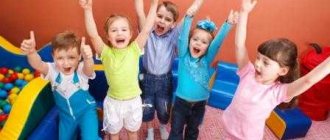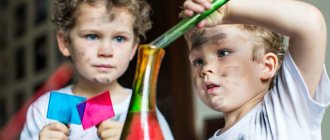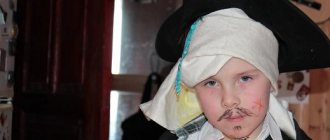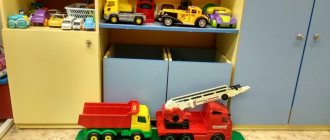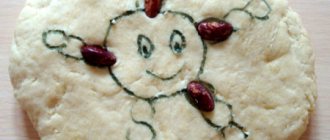Non-standard sports equipment in preschool educational institutions
Non-standard sports equipment in preschool educational institutions pinned post
- Community Posts
- Search
Non-standard sports equipment in preschool educational institutions pinned post
The use of non-traditional aids in physical education classes
Municipal budgetary preschool educational institution “Kindergarten No. 205 “Novograd” of the city of Cheboksary, Chuvash Republic
Prepared by: physical education instructor Galina Vasilievna Larionova.
Non-standard sports equipment in preschool educational institutions pinned post
Non-traditional do-it-yourself play equipment
The booklet presents play equipment for children, made together with parents, which we use to preserve and strengthen the health of children. All equipment is made from waste material.
MBDOU "Tambov kindergarten" in the village of Tambov, Romanovsky district, Altai Territory
Educator: Proskurina Evgenia Nikolaevna
Non-traditional physical education equipment (do-it-yourself)
"Magic rug"
This equipment is made of plastic bottles with caps based on drape fabric.
Designed for barefoot walking, correction and prevention of flat feet, hardening. It is used for physical exercises, during wake-up exercises, and joint sports events with parents.
"Footprints and palms"
This equipment is made from pieces of linoleum.
Used for outdoor activities and entertainment, to reinforce the concepts: “right leg”, “left leg”, “right hand”, “left hand”. Promotes the development of coordination of movement, memory, dexterity, strengthening the muscles of the legs and arms, attention.
"Breeze in a Bottle"
This manual is made from a plastic bottle, colored paper, and cocktail straws.
Used for breathing exercises. Develops respiratory organs.
"Sultans"
Made from sticks and colored ribbons and ribbons.
Designed for performing general developmental exercises, breathing exercises, organizing outdoor games, and competition games. Promotes the development of respiratory organs and trunk muscles.
"Bilboke"
Made from plastic bottles, fishing line, Kinder Surprise capsules, for decoration: colored adhesive paper.
Designed to hit the target. Develops eye, attention, reaction speed, manual dexterity.
"Sports cubes"
Made of plastic cubes, paper with silhouettes of a person performing various exercises.
Intended for use in independent play activities, organized educational activities, and for working at home with parents. Helps strengthen body muscles, develop general developmental exercises, attention, coordination of movements, and speed of reaction.
"Nimble Mouse"
Made from a ball, a mat glued to a wooden base, a spring, and a mouse toy.
Designed to hit the target for playing individually, in pairs, or as a team. Develops eye, attention, reaction speed, manual dexterity.
Expander
Made from five-liter plastic cans and elastic.
Designed to develop strength.
Dumbbells
Made from plastic bottles, colored tape and sand (or other material for filling them).
Designed to develop strength.
Multi-colored balls
Made from small plastic bottles, filled with colored rain, candy wrappers, etc.
Designed to perform general developmental exercises, basic types of movements, massage and self-massage, prevention of flat feet, development of fine motor skills, used as substitute objects for role-playing games.
Tunnel
Made from aluminum hoop and thick fabric.
Designed for climbing. Used in outdoor games, when performing basic types of movement, in role-playing games.
Walkers
Made from painted wooden blocks and clothesline.
Designed to perform basic types of movement, to develop movement coordination, and for independent play activities.
Sports bags
Made of thick fabric and filled with beans, you can use other filler (small pebbles, beads, peas, etc.)
Designed to perform general developmental exercises, basic types of movements, massage and self-massage, and prevention of flat feet.
"BILBOKE"
Material: the top of plastic bottles, a Kinder Surprise container or ball, colored thread or ribbon.
Goal: Improving the ability to throw an object up or catch it; develop the eye, reaction speed, coordination of movements of the forearm and fingers, dexterity, accuracy, eye, arbitrariness of behavior, reaction speed. Cultivating perseverance, perseverance, a positive spirit of competition, developing self-control skills.
Use case: Children throw the container up and catch it with a bottle. If you caught it, well done! Games “Who is the most dexterous?”, “Hit the target”, games of a competitive nature.
The purpose of these guidelines is to increase children's interest in physical education, create a need for independent action, and also attract the attention of parents to the problem of maintaining children's health.
It's no secret that the health of the child comes first for every parent. The most effective and affordable means of increasing health potential is physical education and, above all, physical activity. In practice, we are convinced of a decrease in children’s interest in physical activity, their inactivity, and reluctance to take part in outdoor games. Which leads to an increase in morbidity.
How can we make the world of movements truly attractive and interesting for children and parents? To solve this problem, in our group “Semitsvetik”, we use non-standard equipment made by parents, children and teachers with their own hands, which allows you to quickly and efficiently develop motor skills and abilities and helps to increase interest in physical education activities, making children’s movements more diverse, develop creativity and imagination.
Classes with non-standard equipment can be both entertaining and training in nature; they can be organized in the form of game, plot, thematic, educational and training sessions. The novelty lies in the unusual shape and colorfulness of non-standard equipment, which attract the attention of children and increase their interest in performing basic movements and exercises and contribute to a high emotional tone during classes.
The manufactured non-standard equipment is small-sized and quite versatile, and is easy to process. It is easily transformed with minimal time and can be used both indoors and outdoors.
Non-standard equipment is an additional incentive to intensify physical education and health activities. Therefore, it is never superfluous and boring. For teachers and parents, I offer several examples of non-standard physical education equipment that you can easily make with your own hands.
Magic bottle
A very simple product. To create it you will need a transparent plastic bottle, a cocktail straw, confetti or foil.
You need to make a hole in the lid. A tube will be inserted there. Small confetti, cut foil or large glitter are placed in the bottle itself.
The child should inhale through the nose and exhale through the mouth into a tube. This way he masters the correct breathing technique and watches the cheerful “fireworks” inside the bottle.
Pouch
It would seem, how to use it? But it can be found in many applications. For example, bags can be placed on the head so that children maintain their posture at all times. Since problems with spinal curvature are becoming more common, such exercises will be very useful. You can sew a bag from ordinary thick fabric. The filler will be salt or sand.
Beast racing
Using regular tape, a beautiful stick and a soft toy, you can make an exciting game that will help develop fine motor skills in your child’s hands. A soft toy is tied at one end, and the other end is tied to a handle. It is important that the ribbons are all the same size. The task is simple: you need to twist the handle, winding the rope around it. This way the toy animal will slowly move towards the baby. You can organize whole competitions.
"MASSAGE GLOVES"
Material: Gloves, beads, buttons, threads and needles.
Goal: Increasing the overall tone of the body (help to have a positive effect on the growth and development of the child’s body, relieve fatigue, improve blood circulation, calm the nervous system of preschoolers). Strengthening the immune system and improving the emotional state of the child.
Use: Children massage all parts of the body for themselves and each other.
"AIR FOOTBALL"
Material: Box covered with self-adhesive film, goal cups, foil for the ball and straws.
Goal: Develop breathing, exhalation power. Cultivating perseverance, perseverance, and a positive spirit of competition.
Use: in gaming activities.
The game is installed on the table. There are 1 player on both sides, armed with straws. The balls are placed in the center of the playing field. The players' task is to score the most goals against the opponent's goal. At the same time, they should not touch the ball with their hands, but can only blow on it through the tubes.
If a player touches the ball with his hand or straw, the opponent receives one extra point. By agreement, the players can introduce some football rules.
Master class “Sports didactic games for physical education of preschool children”
MBDOU kindergarten No. 1 “Smile” of compensatory type
for teachers:
“Sports didactic games for physical education of preschool children”
Prepared by:
head of physical education
Aptrieva O.D.
All children are individual, each of them is unique and
you must find the key to everyone!
Play is not only a source of positive emotions, it is also an opportunity to develop qualities necessary for later life. While playing, a child, without even knowing it, can acquire new knowledge, skills, abilities, and develop abilities. Any game is, first of all, communication with peers or adults. And it is at this moment that the child learns to respect other people’s victories and endure his failures with dignity. From the wide variety of games, I would like to highlight didactic games, which in the hands of a teacher become an interesting, exciting, emotional and creative means of educating a child’s harmoniously developed personality. The didactic games for physical education presented below help to consolidate in children the knowledge acquired in thematic classes in physical education. Their main goal is to develop children’s sustainable interest in physical education and sports. All games are multifunctional. They not only develop interest in sports, but also contribute to the formation and development of mental processes:
- development of perception of color, shape, size, space, time; - development of visual and auditory attention; — formation and development of mental operations (comparison, juxtaposition, generalization, exclusion, classification), operations of analysis and synthesis; formation of logical thinking in children; - formation of general and fine motor skills of the hands.
I made all the games with my own hands. To make the games, photographs and symbols of sports, as well as pictures from board games and coloring books, were used.
Methodological recommendations for the use of didactic games in physical education
- Didactic games should be played during independent or joint activities of children and the teacher.
- To play board games, you should choose a table at which all participants in the game can sit comfortably.
- Participation in games by a teacher increases children’s interest in games and contributes to the development of friendships.
- To develop activity and independence, it is advisable to assign the role of leader to one of the children.
- The new game should be clearly and concisely explained, and individual points can be shown.
- The course of the game and its rules are explained before the start. If necessary, the teacher can show and use questions to find out how the children understood the game.
- All instructions during the game should be given in a calm tone, marking the correct completion of tasks and compliance with the rules.
- Children's activities in the game are assessed by all participants; At the same time, it is important to note compliance with the rules, quality of answers, independence in organizing and conducting games.
- After the game, it is necessary to give an objective analysis of the behavior of all the players, their compliance with all the rules, which contributes to the formation of friendly relations and the conscious attitude of each child to his behavior.
Description of educational games
"Sport equipment"
Goals and objectives:
to develop children’s interest in physical education and sports;
introduce children to sports equipment; teach children to recognize and name sports equipment, determine its purpose; develop thinking, attention, memory, logic. Age:
3 – 4 years.
Rules:
The set includes cards with black and white images of sports equipment and color parts of these pictures (from 3 to 12 parts).
The child selects a black and white picture and superimposes the colored parts of the picture onto it. After the child collects the picture, he must name the sports equipment that is depicted on it. Complication:
Collect a picture without relying on a black and white image. Explain how this equipment can be used.
"Fold the picture"
Pictures depicting sports and equipment are cut into various geometric shapes. Goals and objectives:
to develop children’s interest in physical education and sports;
introduce children to sports; teach children to recognize and name sports; develop imagination, thinking, logic. Age:
5 – 7 years.
Rules:
the player assembles a picture from parts. Having collected, the child tells what is shown in the picture.
"Find a Pair"
Goals and objectives:
to develop children’s interest in physical education and sports;
introduce children to sports; teach children to recognize and name sports equipment and equipment, determine what sport it belongs to; develop the ability to analyze and generalize; develop creative thinking and imagination. Age:
3 - 5 years
Rules: Option 1:
play from 2 to 4 people.
The presenter sorts the cards into pairs and divides them equally between the players. On command, players must pick up paired cards and fold them. The winner is the one who first completed the task and correctly named the sports equipment. Option 2:
play from 2 to 4 people and a leader. The presenter sorts the cards: puts one card from a pair into one pile, and the second card into another. He distributes one pile to the players, and places the second on the table with the pictures facing down. The presenter takes one card and shows it to the players. The player who has a pair from this card names what is shown in the picture and what sport it is used in. If the answer is correct. Then the player takes the card for himself, if not, then the presenter keeps the card for himself. The one with the most collected pairs wins.
"Two halves"
Pictures depicting sports equipment and the main types of equipment movements are cut into two halves.
Goals and objectives:
teach children to recognize and name sports equipment and basic types of movement;
develop thinking and memory; develop interest in physical education. Age:
2 – 3 years.
Rules: 1 option.
The child puts the two halves together to make a picture.
Option 2.
The child looks for the desired half in a stack of pictures.
Having collected the picture, the child must name what is depicted on it. Option 3.
Having collected the picture, the child must name what is depicted on it. If this is a movement, then the child must show it. If this is equipment, then the child must find it in the group and show what exercises can be performed with it.
"Good and bad"
Goals and objectives:
teach children to have a healthy lifestyle;
teach children to compare good and bad, useful and harmful; instill in children the desire to lead a healthy lifestyle; develop thinking, logic, memory. Age:
3 – 6 years.
Rules:
children are given cards that depict situations harmful to health. Players must determine why it is harmful and find a pair of cards that depict a situation that is healthy.
“Relax actively”
(cubes)
Goals and objectives:
develop interest in physical activity;
teach children to recognize and name types of outdoor activities; develop memory, thinking, logic. Age:
3 – 6 years.
Rules:
assemble the cubes so that you get a whole image, based on the finished picture.
Complication 1:
after collecting the image, the child must name what is shown in the picture.
Complication 2:
assemble an image from memory without relying on a finished image.
"Sports Domino"
Goals and objectives:
teach children to recognize and name sports;
develop memory, logic, thinking. Age:
4 – 6 years.
Rules:
The dice feature symbols of sports. 2 – 4 people play. Before the start of the game, the dice are laid face down on the table and mixed. Each player chooses any seven dice. The remaining bones remain on the table - this is the “bazaar”. The player who has the double picture tile goes first. If several players have a tile with a double picture, then the first player is chosen by counting. Next, the players take turns placing dice to the right and left of the first, placing the same picture of the other to the picture of one dice. If the player (whose move) does not have a dice with the required picture, then he takes a dice at the “bazaar”. The one who has no dice left (or the fewest) wins.
"Sportloto"
Goals and objectives:
to develop children’s interest in physical education and sports;
teach children to recognize and name sports; develop attention and memory. Age:
5 – 7 years.
Rules:
I play with 2-6 people. Each player takes 2-3 game cards, on which symbols of sports are depicted instead of numbers. The driver takes out a chip with a symbol from the bag, names the sport and shows it to the players. The one who has such a symbol on the game card covers it with a token. The player who covers all the symbols with tokens the fastest wins.
"Sportmemorina"
Goals and objectives:
to develop children’s interest in physical education and sports;
teach children to recognize and name sports; develop memory. Age:
5 – 7 years.
Rules:
2 – 6 people play. Paired cards with sports symbols are laid out face down on the table in random order. Players alternately turn over two cards. If the symbols on the cards are the same, then the player takes them for himself and makes the next move. If the symbols are different, then the cards are turned over and the next player makes a move. The game ends when the players have all the cards. The one who collects the most pairs wins.
"Sports in winter and summer"
Goals and objectives:
to develop children’s interest in physical education and sports;
teach children to recognize and name sports; develop logic, memory, thinking, ability to classify and sort sports. Age:
5 – 7 years.
Rules:
The player is asked to select symbols (images) of only winter or only summer sports. Then he names these sports; explains why they are summer or winter; tells how the winner is determined.
"Sports Guessing Game"
Goals and objectives:
replenish and consolidate children’s knowledge about sports;
develop thinking and memory. Age:
4 – 7 years.
Rules:
the presenter (teacher) mixes the playing fields (each shows 6 different sports) and distributes them among the children.
Then the presenter shows a card with a picture of a sport and names it. The player whose field contains the same sport takes it and places it on top of his field and repeats the name. The player who covers their playing fields with cards the fastest wins. Complication:
play the same way, but the name of the sport is called by the player on whose field there is the same sport. In case of an incorrect answer, the presenter names the correct answer, gives the card to the player, and the player places a penalty token on top of the card that he placed on the playing field. The one with the fewest penalty tokens wins.
"The Fourth Wheel"
Goals and objectives:
develop interest in physical education and sports;
consolidate children's knowledge about sports, physical education, hygiene and health; develop logic, thinking, memory. Age:
4 – 7 years.
Rules:
The player takes one card with four pictures on it. The player names what is shown on the card, then covers the extra picture, explaining why it is extra.
“Get ready to exercise”
Goals and objectives:
to develop children’s interest in physical education and sports;
teach children to compose exercises for morning exercises; develop memory, thinking, logic. Age:
5 – 7 years.
Rules:
The player chooses a picture card for the starting position. Then he selects movements for the exercise itself (counting 1-2 or 1-4) so that the intermediate positions of the body and limbs are combined. After composing the exercise, the child must complete it. There can be several people playing. They take turns creating an exercise, and the rest must complete the task.
"What is what"
Goals and objectives:
to develop children’s interest in physical education and sports;
teach children to recognize and name sports; learn to identify and name the necessary inventory, equipment, equipment for a given sport; develop thinking, memory, logic. Age:
5 – 7 years.
Rules:
The player selects a card with a sport. Next, he selects the symbol of this sport, inventory and equipment for it. Several people can play at the same time: whoever collects the row faster.
"Collect a symbol"
Goals and objectives:
to develop children’s interest in physical education and sports;
introduce children to the symbols of sports; teach children to recognize and name the sport; develop thinking, attention, memory. Age:
5 – 7 years.
Rules:
From the cut pieces the player assembles a symbol of the sport. Then he names this sport and talks about it.
"Sports Four"
The game uses cards depicting the sport and its symbol. They are divided into groups of four cards, united by one symbol (standing in the upper corner), but having different images of this sport.
Goals and objectives:
to develop children’s interest in physical education and sports;
teach children to distinguish between sports (by season, by equipment, by location); develop memory, thinking, logic. Age:
4 – 7 years.
Rules:
4 – 6 people play. Players are dealt 4 cards. The task of each player is to collect a group of cards with one sport. To do this, players pass each other the unwanted card face down in a clockwise direction. The winner is the one who collects 4 cards with one sport faster.
"Me and my Shadow"
Goals and objectives:
to develop children’s interest in physical education and sports;
teach children to recognize starting points; develop attention and memory. Age:
5 – 7 years.
Rules:
I play with 2-6 people. Each player takes 2-3 game cards, which depict silhouettes of the starting positions and movements. The driver takes out a chip with a colored image from the bag and shows it to the players. The one who has the silhouette of this image on the game card takes a chip and covers the silhouette with it. The player who covers all the silhouettes with images the fastest wins.
"Make a guess - guess"
Goals and objectives:
to develop children’s interest in physical education and sports;
teach children to recognize sports by characteristics and definitions; teach children to guess a sport based on its characteristics and definitions; develop memory, thinking, logic. Age:
5 – 7 years.
Rules:
2 or more people can play. The driver (adult or child), using cards - “definitions and signs”, guesses the sport. Players try to guess the sport. The one who guessed correctly becomes the driver.
Cards of definitions and characteristics
"FUNNY PENCILS"
Material: the equipment is made of colored pencils or felt-tip pens, the Kinder container is a surprise.
Purpose: to promote the prevention of flat feet, foot massage. Improves blood circulation in fingers, hands and forearms.
Options for use: Palm massage (rotating the barrel of a pencil between the palms), massage of the fingertips, massage of the back and inside of the palm. Foot massage, lifting a pencil with your toes. Use as attributes.
